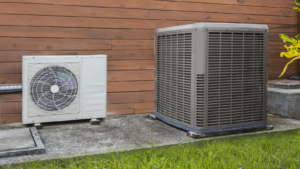Home >
How to choose the right heating system for your self-build home

Welcome to the second article in our green self-build guide – a weekly series of articles aimed at people building their own properties who want to go green and save.
Last week we looked at what to consider when designing your self-build, and why installing renewables is important for your home’s Standard Assessment Procedure (SAP) score. This week, we look at the different systems and options available to you.
Renewable heating – the options
Heating accounts for most of our home’s energy demand and carbon emissions. That’s why it makes sense to consider installing a renewable heating system if you’re building your own home. Luckily, there are several renewable heating options you can consider for your self-build.
Air source heat pumps
Air source heat pumps (ASHPs) work by extracting heat from the air outside and transferring it indoors. Even when outside temperatures are as low as -15 degrees Celsius, ASHPs are still effective at extracting heat. This makes them a suitable heating technology all year round,
There are two main types of ASHP: air-to-air and air-to-water.
Air-to-air heat pumps need a warm air circulation system to distribute heat around your home, but they will not provide you with hot water as well. Air-to-air heat pumps are not eligible for the UK government’s Renewable Heat Incentive (RHI). We’ll look at the RHI in the final part of our self-build series.
Air-to-water heat pumps – which are the most common model in the UK – work most efficiently when delivering heat at a lower temperature than a conventional boiler. With this type of heat pump, you should consider using wet underfloor heating or large radiators with a large surface area, allowing them to supply heat at lower temperatures over longer periods of time.
If you’re thinking about an ASHP you’ll need a suitable place to locate it. An ASHP needs outdoor space with free-flowing air, ideally in a sunny spot. You’ll also need space indoors for the compressor. The amount of space will depend on the system you choose, but you’ll need space for a hot water cylinder as a minimum. It will make a low-level humming noise, so bear this in mind when deciding where to put it.
Ground source heat pumps
Ground source heat pumps (GSHPs) use coils buried in the ground to extract heat from the surrounding soil. The length of the coil, or ground loop, required depends on the property’s heat demand.
Your plot doesn’t need to be particularly big to accommodate a GSHP, but you will still need enough space surrounding the property to lay the ground loop, including access for machinery to install it. If space is limited, another option is to drill a vertical borehole.
The installation process is disruptive as the ground must be dug up to form horizontal trenches or a deep vertical borehole. However, after it’s installed the ground can be re-landscaped so you won’t notice the pipes.
Biomass
Wood-fuelled heating systems – also called biomass systems – burn wood pellets, chips or logs to provide warmth in a single room or to power central heating and hot water boilers. They work in a similar way to traditional gas and oil boilers but burn wood instead of fossil fuels to generate heat. Traditional radiators distribute the heat.
While burning wood does release carbon dioxide, it only releases carbon that has been taken in by the tree during its lifetime. For this reason, biomass is considered a low-carbon energy source.
Although the price of wood fuel varies, it may be cheaper than other heating options. To make sure you have a reliable supply of fuel, check if you have a choice of suppliers in your area. Logs should come from a local source, as transporting them over long distances increases the cost and carbon emissions. To maximise efficiency, it’s also important to only burn dry wood pellets or logs, depending on which boiler or stove you opt for.
If your property has a high heat demand and you have enough space to house the boiler and store the wood, biomass could be a good choice.
Solar thermal
Solar water heating systems – also called solar thermal systems – use energy from the sun to heat hot water. This can then be stored in a hot-water tank or thermal store until you need it.
Solar thermal systems are usually used alongside a conventional boiler, electric immersion heater or another renewable heating system. They’ll provide about half of the hot water you need– the other system tops up the tank when more hot water is needed, or to heat the water further.
To decide if installing solar thermal is suitable for your build, you’ll need to consider how many occupants will live in the property. You’ll need one metre squared of panel per person, but larger families – who use more hot water than single occupants – are likely to get the most benefit.
You’ll also need to consider where best to locate them. Panels work best when sited on a roof facing between south east and south west, with little to no shading. The optimal angle for solar thermal is quite steep to maximise their performance throughout spring and autumn, but many people fit systems at angles of between 30 to 35 degrees to match the slope of their roof.
Mechanical ventilation and heat recovery
Heat-recovery systems recycle heat that would otherwise be lost, providing heating or hot water where it is needed.
There are strict requirements on the airtightness of self-build properties as too much air leakage leads to unnecessary heat loss. However, to maintain good indoor air quality, some form of ventilation is required.
When designing your self-build, consider incorporating a system that provides effective ventilation without expelling valuable heat. Mechanical ventilation and heat recovery combines heating and ventilation by extracting warm, stale air from the property through a series of ducts. It then uses the warmth in this air to heat up cool, fresh, incoming air using a heat exchanger.
Which system is best for you?
Everyone is different and our lifestyles and behaviours vary, so think carefully about what’s best for you and your property. For example, if you use a lot of hot water, then solar thermal may be a good option. If you have mobility problems, then you may find refilling biomass fuel stores challenging.
And remember – with all these technologies you’ll still need a well-insulated home to maximise their effectiveness, so make sure you insulate the property as well as you can.
Next time, we’ll explore why solar electricity panels and energy storage can be a great option for self-build homes.
Want to know more?
Watch our webinar on how to find out which renewable heating system is right for you.
Find out more and request a call back from one of our specialist renewables advisors for free, expert advice.
More in our green self-build guide:



